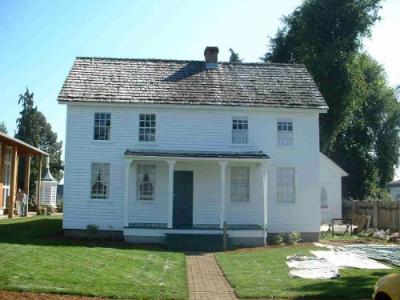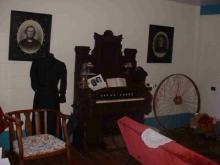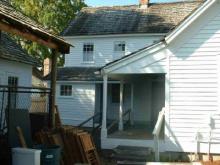Von der Ahe House
This story was taken from "Pioneers", authors: Judith Chapman, Gail McCormick and Champ Clark Vaughan
The historic Fred Vonder Ahe house and summer kitchen were built in 1869 for Christian Frederick and Marie Kline Vonder Ahe and their children, and was originally located on the Vonder Ahe farm near the community of Carus on the main wagon road between Oregon City and Molalla. A portion of the original farm, known today as Evans Farms, is still owned by Vonder Ahe descendants. For many years, the house was a popular stage coach stop. In 1972, the house was acquired by the Molalla Area Historical Society and moved to their present location adjacent to the Dibble house where restoration continues today. The Vonder Ahe House has been listed on the National Register of Historic places since 1976.
The Vonder Ahe house was built in 1869 and is a box style construction. The Vonder Ahe family provided meals and sleeping arrangements for the people traveling on the stages between Portland and Salem. It houses display items and some period furniture. The separate "summer kitchen" is an interesting part of the family story.
Christian Frederick Von der Ahe was born in 1828, in Wesphalia, a principality that was united by the influence of Bismark into Prussia and the Germany known before World War II. His family lived in the small town of Hilla. King Wilhelm rules Westphalia and his pride and joy was the Calvary. Von der Ahe, called Fred by his family, heard of mistreatment of the troops by brutal officers. Around the same time, he heard of a place of opportunity--a place called America.
In 1847, he fled Westphalia, seeking a life in America. Like many of the early adventurers, he would never see his homeland again. It was a hard choice to make. He was to leave his beloved, 16 year-old Marie Louisa Kline. Promising to send for her as soon as he could, Fred departed on a sailing ship headed for New York City.
Marie Louise promised to wait for him. At the same time, she didn't know that long hours would turn into long days that turned into long years of waiting. During those years, she gathered together her trousseau. Spinning and weaving, she turned wool into cloth and dreamed of the time they would be together again.
Fred made it to New York City and quickly moved on. On foot, or however he could, he traveled until he reached a place called Blue Island, Ill. There was a canal being built that would connect Lake Michigan to the Illinois River. Jobs paid $1 per day. The sensitive German boy, speaking very little English, found himself working with the rowdy, boisterous Irishmen who were settling Northern Illinois. Not understanding the German nature, one evening they forced him into an Irish pub and ordered him to buy drinks. Fred was saving every cent he could for his future life with Marie and protested. Angry, the Irish roughed him up and tossed him from the pub.
Fred's next stop was a farm in Illinois. Owned by a family named Rexfort, it was a friendly stopping place for farmers from on the prairie who went to Chicago to trade. For a small fee, they could stay overnight and stable their horses. Making $6 a month, plus board and room, Fred cleaned stables and helped wherever needed. Here he stayed for three years and started to master the English language. It was here that he heard stories of the Oregon Country.
In 1852, Fred met a man who was taking an ox-drawn wagon and joining a wagon train for the Oregon Country. Fred paid to ride along with him. About the time they reached Fort Hall, Fred and the man had a disagreement and Fred left, walking the rest of the way to Oregon City. Along the way, he got pretty hungry and had to pay top price to buy food from the pioneers, sometimes paying $1 for a biscuit. Germans were known for their hiking about the countryside and Fred hiked along at a good pace--even passing the wagon train he had set out with. With a quick hike over Mount Hood, via the Barlow Road and down Laurel Hill, he arrived in Oregon City two weeks before the wagons.
In 1852, Oregon City was barely a town, but it was the hubbub of activity and a jumping off spot for the Oregon Trail pioneers. Fred quickly found a job working for Pope's Hardware Store. Driving a dray, he made deliveries and worked on the Pope's small acreage near what is now the corner of Warner-Milne and Leland Roads. While working for Pope, he made $5 per day.
It had now been six long years since he'd left Marie Louisa and the letters had been few and far between. Somehow, Fred knew she'd wait until he could send for her. Living as frugally as possible, he put his money aside for the day when they could be together.
On his free days, Fred took long walks into the countryside. He soon encountered a man, who had taken out a 320-acre donation land claim at a place called Carus. It was a stopping place for travelers between Oregon City and Mulino. The man had worked hard, but had been able to clear only six acres and was discouraged. Fred had fallen in love with the property--with its springs, rolling hills and tall forests.
Week after week, he walked to the property and talked to the man. Finally they came to an agreement. Fred would buy the property for $600 in gold and a deal was sealed on August 15, 1857.
By now, 10 years had passed since Fred left Westphalia. Ten years since he had seen his younger brothers and sisters, his parents and Marie. Homesickness for the German traditions often set in. He missed his mother's cooking--the sauerbraten, the kaffee kuchen, the schmeer kase dumplings. And, oh, how he missed the herring salad at New Years and the wienachts brod at Christmas. Fred moved into the log cabin the previous owner had built. Excitedly, he sent for Marie Louisa and bought a shiny new cookstove for her to prepare the rich German delicacies for him.
Fred bought a pony so he could ride back and forth to his job at Pope's Hardware Store. By the time Marie Louisa got to Oregon City he would have a team and wagon.
In the meantime, the little community of Hilla was a buzz with the news that Marie Louisa, along with her sister, Elizabeth, were leaving for America. Nothing like this had ever happened in their little town before. Determinedly, Marie Louisa packed the fruits of her years of waiting--bolts and bolts of heavy colored and plaid linen for suits and dresses. And there were bolts of white linen for sheets, pillow cases and towels.
In February 1858, the two Kline girls bade farewell to family and friends. The sailing ship, Aristias, brought them to New York City. Along the way, they learned a smattering of the English language. They bought new dresses and bonnets in New York City. The custom in New York City was to wear dresses with the sleeves standing straight up, so the girls stuffed newspapers in their sleeves.
By spring they were onboard a ship bound for San Francisco. The trip was long and difficult but they arrived in San Francisco by the end of July. Travel beyond was by stagecoach to Oregon City. The journey overland was hard with many stops to change horses and uncomfortable overnight accommodations.
New York City was exciting and San Francisco was a bustling city. Nothing prepared them for their first sight of Oregon City. What was this broken down little town? Mud streets and rough pioneers.
The little settlements nestled below the falls along the Willamette River was no exciting, bustling city. It was a few buildings and houses straggling up a dusty street. The girls watched as stern-wheelers chugged up the river. The giggling girls soon became subdued. This was a man's town--not a town for dainty ladies.
But when her eyes caught sight of Fred, Marie Louisa knew her dreams had come true. Somehow, he looked different, but the love was the same. It was as fresh and sweet as when they had courted in Westphalia.
Fred and Marie Luisa were married August13, 1858, and the two girls joined Fred at his little log cabin. Children soon arrived: Mary Julia in 1859; Charles Willaim in 1861; Mary Louise in 1862; Ernest Heinrich in 1864; Christian Ludwig in 1866 and Christian Frederick Jr. in 1871. By 1865, Fred was able to build a new home for his family--a real house with lumber and shuttered windows.
Now, 131 years later, you may tour this house. It is lovingly restored and cared for by the Molalla Historical Society. An unusual feature is a small building known as the summer kitchen. Early pioneers often built separate summer kitchens in case of fire. Although it is next to the house now, in its original setting it was built about 40 feet from the "big house".
With the help of his family, Fred cleared the land and built a drying house and the family went into the business of raising and drying apples. The peels and trimmings went into a vinegar barrel and Von der Ahe vinegar earned a reputation for excellence for miles around. The house was also a stopping place for travelers, often staying overnight in the upstairs rooms. Indians, passing through, often camped in front of the house.
The name Caras was often misspelled as Carus and around 1900 the post office changed the name permanently to Carus. Today this quiet spot along Highway 213 sports one of the best elementary schools in the nation, the Evan's Farm and a historic church.
Maria Louisa died in 1905 and Fred in 1909. At his death, the farm was divided among the six children. The old farm is called Evans Farm, after Clarence Evans, who married into the family. Today it is a thriving nursery business still operated by descendants of the Von der Ahes.
Click any thumbnail image to view a slideshow



